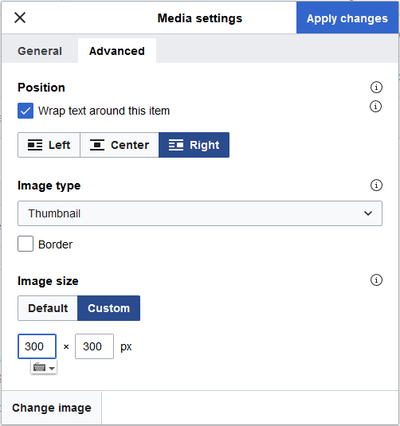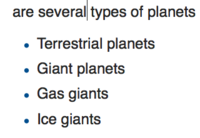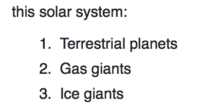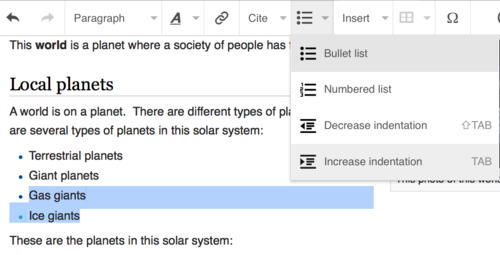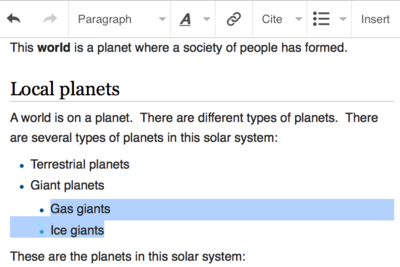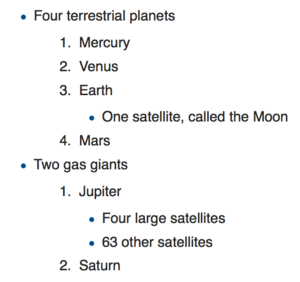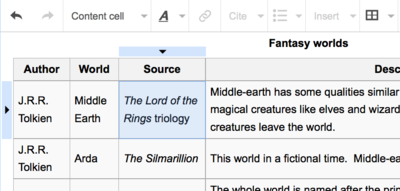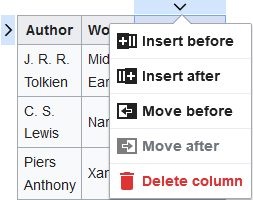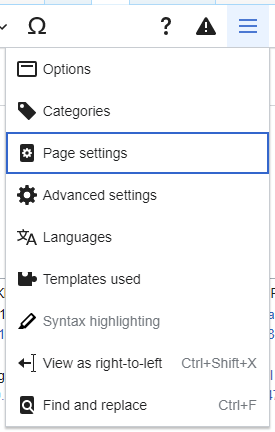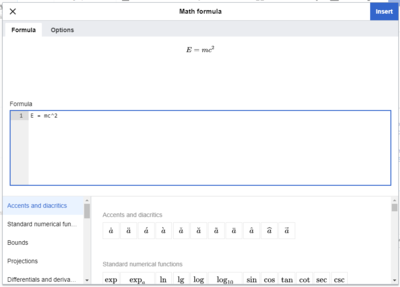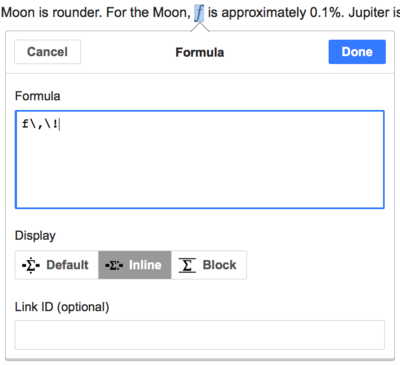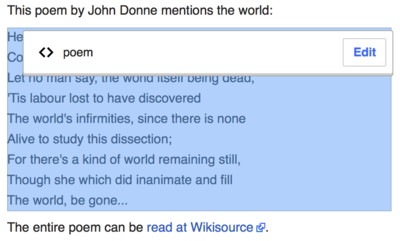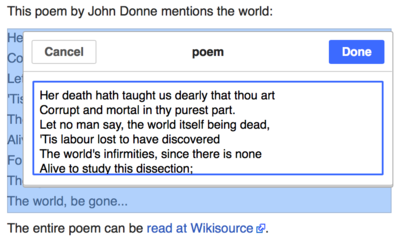Agiûtto:VisualEditor/Goìdda uténte
| Note: When you edit this page, you agree to release your contribution under the CC0. See Public Domain Help Pages for more info. |
| VisualEditor portal |
|---|
 |
| General |
| About |
| Help with the launch |
| Se ti ti vœ provâ VisualEditor sénsa modificâ 'na vôxe, tò-u chi 'na pàgina pe fâ de prêuve. Ti no t'hæ bezéugno de 'n account pe dêuviâ VisualEditor inte quélla pàgina. |
Arvî o VisualEditor
Introduçión: a bâra d'instruménti de VisualEditor
| A bâra d'instruménti de VisualEditor a conpare inta pàrte superiôre do schèrmo quànde ti t'iniçi a fâ de modìfiche con VisualEditor. A inclùdde de icónn-e comùn: | |
| Anùlla e Ripeti i cangiaménti che ti t'hæ fæto. | |
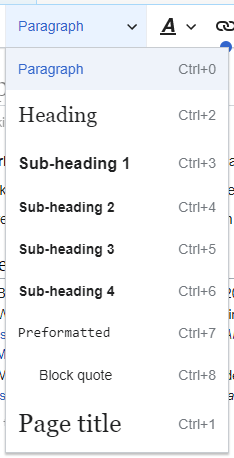 |
Menù a tendìnn-a di tìtoli de seçioîn: o permétte de cangiâ a formataçión do paràgrafo. Pe cangiâ o stîle de 'n paràgrafo spostâ o póntató do mouse, seleçionando 'n eleménto da-o menù (a no l'è necesâio do tèsto). I tìtoli de seçioîn són coscì formatæ $format e e sóttaseçioîn $subheading2, $subheading3 e coscì vîa. To change the style of a paragraph, put your cursor in the paragraph and select an item in this menu (you don't have to highlight any text). Section titles are formatted "Intestassion", and subsections are "Sottintestassion 1", "Sottintestassion 2", and so on. O formâto normâle o l'è Paraggrafo. |
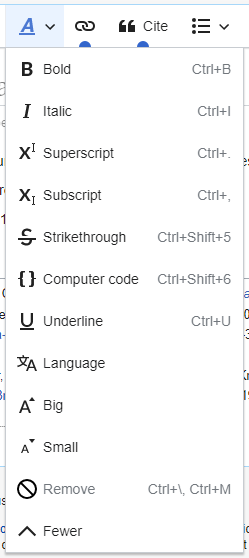 |
Formataçión: sciacando in sciâ "A" o s'avre 'n menù.
Se ti no t'hæ seleçionòu nisciùn tèsto quànde ti ti prémmi "A" pe arvî o menù e pöi ti ti çèrni 'n eleménto, quélla formataçión a saiâ aplicâ a-o tèsto che ti t'hæ comensòu a scrîve, a prescìnde da dónde se trêuva o póntatô do mouse. |
 |
Instruménto de colegaménto: l'icónn-a co-e cadénn-e a l'è l'instruménto pe fâ di colegaménti. Sciacando quésta icónn-a (solitaménte dòppo avéi seleçionòu do tèsto) s'arve o diàlogo do link. |
 |
Çita: o menù Çìtta o serve a inserî 'na çitaçión into pónto indicòu (dîta nòtta a pê de pàgina ò nòtta de tèsto ascì). Tùtti i progètti àn a poscibilitæ de acêde a-a formataçión de bâze de nòtte e a poscibilitæ de riutilizâ 'na nòtta, gràçie a quésto menù. Quésto menù o dâ a poscibilitæ de acêde a-i template de çitaçión ascì, se prezénti in sciâ tò wiki. |
 |
poméllo Çìtta: Se o servìçio Citoid o l'è abilitòu in sciâ tò wiki, ti ti véddiæ o poméllo Çìtta a-o pòsto do menù Çìtta.
(E instruçioîn pe azónze o menù Manoâ a 'na wiki in particolâ s'atrovàn a-a pàgina VisualEditor/Citation tool) Instructions for enabling the Outomàtico tab are available at Enabling Citoid on your wiki O servìçio Citoid o tenta de conpilâ 'n template de çitaçión outomaticaménte. |
 |
Elénchi e indentaçioîn: e prìmme dôe icónn-e perméttàn de formatâ o tèsto ségge cómme Lista co-i ponti ségge cómme Lista numerâ. E ùrtime dôe icónn-e perméttàn pe cóntra d'aomentâ ò amermâ o livèllo de indentaçión di eleménti da lìsta. |
 |
Inseisci: o menù Inseisci o poriéiva êse despægio tra i vàrri progètti. Chi de sótta s'atrova 'na lìsta de tùtte e scèlte che poriéivan êse mostræ.
|
| Inseriménto caràteri speciâli: l'icónn-a Carattere speciale (Ω) a s'atrova vixìn a-o menù Inseisci. Quànde a vêgne seleçionâ, s'arve 'n barcón de diàlogo ch'o mostra vàrri caràteri speciâli. Sciacando in sce 'n caràtere specìfico quésto o saiâ inserîo into tèsto. I caràteri speciâli inclùddan di scìnboli stàndard, acénti vàrri e scìnboli matemàtici. (Quésta lìsta a pœ êse modificâ localménte. Véddi VisualEditor/Special characters pe-e instruçioîn.) | |
| O poméllo Modifica avîsi o mostra ògni avîso da-a pàgina. | |
 |
O menù $pagemenu o s'atrovâ a mancìnn-a de $save e do menù Cangia editor. Inte quésto menù o gh'è 'n poméllo pe arvî 'n barcón de diàlogo Scèlte co-e segoénti schêde (a mancìnn-a):
E tabélle do barcón de diàlogo "Scèlte" són mostræ ascì into menù $pagemenu e pœan êse avèrte sciacando sórva de quéste. De ciù o menù $pagemenu o contegne o poméllo Véddi cómme drîta-a-mancìnn-a e o poméllo Trovâ e rinpiasa, i quæ arvian o barcón de diàlogo dónde ti ti pœ inserî caràteri, tèrmini ò esprescioîn che ti ti stæ çercando ò quélle che ti ti vœ sostitoî, insémme a vàrri pomélli pe divèrse inpostaçioîn. |
| O poméllo pasa a l'editor vizoâle o s'atrovâ vixìn a-o poméllo $save. O permétte de pasâ a l'editor de wikitésto. | |
Publicâ de modìfiche
Modificâ i colegaménti
 |
Se pœan azónze di colegaménti atravèrso l'icónn-a Ingancio (a quæ a rafigua 'na cadénn-a) inta bâra d'instruménti, òpû dêuviando i tàsti ràpidi Ctrl+K (ò ⌘ Command+K in sce 'n Mac).
Se ti ti seleçioni (evidençi) 'n tèsto e dòppo ti ti prémmi o poméllo Ingancio, quéllo tèsto o saiâ dêuviòu pe creâ o colegaménto. Pe 'n colegaménto ch'o inclùdde 'na sôla paròlla ti ti pœ seleçionâ ò quélla paròlla òpû métte o pontatô do mouse in sciâ paròlla. |
 |
Ségge se ti t'adêuvi o poméllo ò i tàsti ràpiddi, o s'arviâ 'n barcón de diàlogo dónde poéi scrîve o colegaménto.
L'instruménto pe-i colegaménti o daiâ 'na màn co-i colegaménti intèrni, çercando e cóbie probàbili. Quànde ti t'hæ scrîto ò seleçionòu o colegaménto ti ti conpleti o procèsso de colegaménto sciacando ↵ Enter òpû o poméllo Fæto. O tò colegaménto o conpariâ sùbito inta pàgina ma, coscì cómme i âtri cangiaménti, o no saiâ publicòu scìn a-a publicaçión de tùtta a pàgina. |
 |
Pe fâ 'n colegaménto a 'na pàgina web inte 'n âtro scîto d’Internétte, o procèsso o l'è scìmile: ti ti çèrni a schêda Scito esterno e ti t'inserisci 'n URL inta cazélla. |
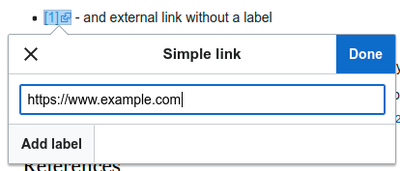 |
I colegaménti estèrni saiàn mostræ coscì: [1]. Quésti pœan êse azónti spostando o póntatô do mouse lónxi da de paròlle (prezénpio dòppo in spàçio). Arvî l'instruménto pe-i colegaménti sciacando in sciô poméllo ò dêuviando a scorsaieu da tastêa. Scrîve l'URL inta cazélla e sciacâ o poméllo Fæto pe inserî o link. |
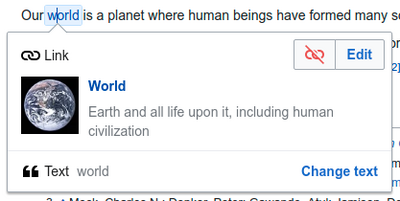 |
To change or remove an existing link, press within the text for that link, then press the "Ingancio" icon that appears near it. The dialog will appear, for editing. You can also get to the dialog with the Ctrl+K keyboard shortcut. Quànde 'n colegaménto o l'è seleçionóu, o apare colorîo de bleu.
Into procèsso de colegaménto ti ti pœ cangiâ dónde o va o colegaménto. Ti ti pœ ascì levâ do tùtto o colegaménto sciacando o poméllo Leva, in âto a drîta into barcón de diàlogo. Ti ti pœ ascì arvî l'òbietîvo do colegaménto inte 'n âtra pàgina sciacando in sciô colegaménto into barcón de diàlogo, scistêma ch'o serve ascì pe verificâ a validitæ de 'n colegaménto estèrno. Se ti ti vœ sciortî da-a modìfica do tèsto mostróu cómme 'n colegaménto, continoando a scrîve sùbito dòppo, ti ti pœ prémme →:
Pe modìficâ a scrîta into colegaménto de un za existénte, sciacâ into tèsto do colegaménto e scrîve quéllo nêuvo. Ma se ti ti vœ rinpiasâ tùtta a scrîta, nòtta che:
|
Modificâ e nòtte
- For further information, see Agiùtto a l'ûzo di templates de çitaçión ò Agiùtto a l'ûzo do poméllo citoid's Outomàtico
|
Determinâ quæ scistêma o l'è dêuvióu | |
| A tó wiki a pœ dêuviâ 'n di tréi scistêmi de nòtte poscìbili. O prìmmo scistêma o l'è o ciù sénplice, dónde o menù Çìtta (mostròu a drîta) o no inclùdde nisciùn di templates de çitaçión. Se a tó wiki a l'adêuvia quésto scistêma, alôa tùtto quéllo che ti pœ servî da savéi in scê nòtte a s'atrêuva inte quésta pàgina. |  |
 | |
| In the second system, you again start by pressing the Çìtta button. Then a dialog box opens, which includes several popular citation templates set up for quick access in the "Manoâ" tab. Se a tó wiki a l'adêuvia quésto scistêma, alôa ti ti pœ trovâ ciù detàli a Help:VisualEditor/User guide/Citations-Templates. |  |
| Into tèrso scistêma, ti ti pœ iniçia sciacando o poméllo Çitta. Alôa o s'arve 'n barcón de diàlogo, o quæ o inclùdde 'n procèsso de çitaçión ch'o l'adêuvia o servìçio citoid. Se a tó wiki a l'adêuvia quésto scistêma, alôa ti ti pœ trovâ ciù detàli a Help:VisualEditor/User guide/Citations-Full. | 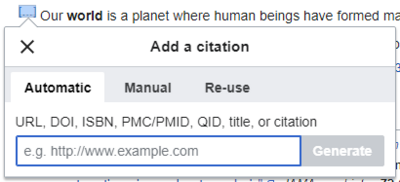 |
|
Modificâ 'na nòtta existénte | |
| Pe modificâ 'na nòtta existénte, sciacâ in sce quésta dónde a conpare into tèsto (de sòlito cómme 'n nùmero tra paréntexi). Ti ti véddiæ ò 'n'icónn-a $ref (segnalìbbro) ò 'n'icónn-a (e nómme) pe-o template ch'o l'è stæto dêuviòu pe creâ quésta nòtta. In ògni câxo, sciacando in sciô poméllo Edit o conpariâ o barcón de diàlogo da dónde ti ti pœ modificâ a nòtta. |  |
| Pe l'icónn-a $ref, sciacâ Edit o l'arve o barcón de diàlogo. Pe comensâ a cangiâ e informaçioîn inta nòtta, sciacâ in sce quésta.
Vàrie wikis dêuviàn di templates pe formatâ e nòtte. Se 'n template o l'è dêuviòu inte 'na nòtta, quànde ti ti mesci o póntatô do mouse sórva e informaçioîn da nòtta tùtte e informaçioîn chi contegnûe saiàn evidençiæ. Se 'n template o l'êa stæto dêuviòu e ti ti prémmi in scê informaçioîn da nòtta, alôa l'icónn-a $template (o tòcco do puzzle) a conpariâ con de informaçioîn. Sciacâ in sciô poméllo edit pe modificâ o contegnûo do template atravèrso o sò barcón de diàlogo. |
 |
| Se quéllo ch'o conpare quànde ti ti prémmi in sce 'na nòtta o l'è 'n'icónn-a pe 'n template stàndard pe-e çitaçioîn (ti ti pœ védde 'n ezénpio chi a drîta), alôa sciacando Edit se arvîa o sò barcón de diàlogo. |  |
| Into barcón de diàlogo do template ti ti pœ azónze ò levâ informaçioîn, ò cangiâ o contegnûo atoâle. Sôlo i cànpi (paràmetri do template) che l'àn 'n contegnûo doviéivan êse vixìbili a l'inìçio. Pe azónze di nêuvi cànpi, sciacâ in sciô poméllo Aggiungi in bàsso a-o barcón. |  |
| Prémmi in sce Apprica modiffiche quànde ti t'hæ finîo. | |
Riutilizâ 'na nòtta existénte | |
| Se a pàgina a contegne za 'na çitaçión a-o tèsto che ti ti vœ çitâ, alôa ti ti pœ çèrne de riutilizâ a nòtta za existénte.
Pe riutilizâ 'na nòtta za existénte, mesciâ o póntatô do mouse into pónto do tèsto dónde ti ti vœ azónze a nêuva nòtta (nùmero) pe quélla çitaçión. Alôa prémme in sce l'eleménto "Riutilizâ nòtta", da-o menù "Çìtta". (Nòtta: se a tò wiki a l'ha o tèrso scistêma de nòtte sórva descrîto, ti ti véddiæ 'na scrîta Riutilizâ into barcón de diàlogo, in càngio de 'n eleménto Riutilizâ into menù $cite.) |
 |
| Into Nòtta diàlogo, amia a-a lìsta de nòtte e seleçionn-a quélla che ti ti vœ riutilizâ. Se gh'è ciù de ina nòtta, ti ti pœ dêuviâ o barcón de riçèrca (ciamòu Çèrca inte çitaçioìn prezénti) pe fâ a lìsta sôlo de nòtte che contegniàn 'n çèrto tèsto. |  |
Azónze 'na nêuva nòtta | |
| Pe azónze 'na çitaçión dêuviando o menù Çìtta, spostâ o póntatô do mouse dónde ti ti vœ azónze a nòtta into tèsto. Alôa seleçionâ o corètto tîpo de çitaçión into menù. Then click "De baze". |  |
Dêuviâ a çitaçión bâze | |
| Quéllo ch'o l'è mostróu chi o l'è quéllo che ti ti véddiæ se ti ti seleçioni l'eleménto pe-e nòtte de bâze. Inte l'editor de-e nòtte, ti ti pœ azónze a tò çitaçión, formataçión inclùza.
Ti ti pœ ascì inclùdde a nòtta inte 'n çèrto grùppo, âtriménti quésto cànpo o saiâ lasciòu vêuo (quésta scèlta a l'è dêuviâ pe mostrâ i grùppi de nòtte co l'instruménto Lìsta de nòtte). |
 |
| Into barcón de diàlogo de nòtte, se ti ti vœ inclùdde 'n template de çitaçión ò 'n di âtri inte 'na nòtta, sciacâ l'icónn-a Modello ('n pésso de puzzle) inta menù d'instruménti Inseisci, inte l'editor de nòtte. |  |
| Dónca, çercâ o template ch'o se vœ dêuviâ, da azónze e modificâ cómme tùtti i âtri templates (véddi a seçión Modificâ i templates ciù de sótta se a gh'è bezéugno de ciù informaçioîn in scî templates).
Dòppo avéi azónto 'n nêuvo template, sciacâ in sce Apprica modiffiche pe ritornâ a l'editor de nòtte e de nêuvo in sce Apprica modiffiche pe tornâ a-a modìfica da vôxe. |
 |
| Se inta pàgina o no l'è ancón prezénte 'n elénco de nòtte (prezénpio quànde se azónze a prìmma nòtta da pàgina), o va azónto pe fâ vizoalizâ o tèsto da nòtta.
Poxiçionâ o póntatô do mouse dónde se vœ che séggian vizoalizæ e nòtte (de sòlito a-a fìn da pàgina) e sciacâ o menù Inseisci, in sce l'icónn-a Lìsta de nòtte (tréi lìbbri). |
 |
| Se ti ti dêuvi vàrri grùppi de nòtte, câxo de sòlito râro, ti ti pœ specificâ o grùppo inte quésto diàlogo. Sôlo e nòtte ch'apartegnian a quèllo grùppo saiàn mostræ inta pàgina inta poxiçión dónde o se trêuva o grùppo de nòtte.
L'ùrtimo pasàggio into barcón de diàlogo da lìsta de nòtte o l'è quéllo de sciacâ Inseisci. |
 |
Dêuviâ i templates de çitaçión | |
| A tò wiki a poriéiva avéi di templates de çitaçión de ciù into menù Çìtta. Se o l'è coscì ti t'hæ 'n colegaménto ràpido co-i templates de çitaçión ciù dêuviæ inta tò wiki. (E instruçioîn pe azónze templates de çitaçión de ciù inta tò wiki s'atrovàn a-a pàgina VisualEditor/Citation tool) |  |
| Sciacâ in sce l'icónn-a do template Çita lìbbro o l'arve l'editor de quéllo template. Cànpi pe-e informaçioîn ciù inportànti saiàn evidençiæ co-în asterisco. Méntre i cànpi ciù comùn saiàn mostræ, no tùtti di quésti són domandæ. |  |
| Pe azónze ciù paràmetri, dâ ’na scòrsa a l'editor do template e sciacâ in sce a çèrnia Aggiungi.
Prémmi in sce Inseisci quànde ti t'hæ finîo. |
 |
Modificâ e inmàgine e âtri files multimediâli
Uploading images
Editing media galleries
Editing templates
The powerful MediaWiki template system lets you insert dynamic content, text from other pages, and much more. For a detailed explanation and examples, see the Templates help page.
In the VisualEditor you can search for a relevant template, add an invocation or transclusion on the page you’re editing and, if needed, add custom content using parameters.
Insert new template
| To add a template to a page, place your cursor at the position on the page where you want the template to be inserted. Then open the Inseisci menu and select " |
 |
| Find the template you want to insert by typing either its name or a relevant keyword. Results containing the search term in either the name or description will display in a dropdown. This should help you find a relevant template, even if you don’t know its exact name.
If you’re having trouble finding the kind of template you want by using keywords, you can look on other wiki pages with similar content and view or edit the page source to see which templates are in use. When you find the desired template’s name, you can type it into this field to insert it here. |
 |
| You can also edit a template that’s already on a page. When you select the template you want to edit, it turns blue, and a box appears displaying " |
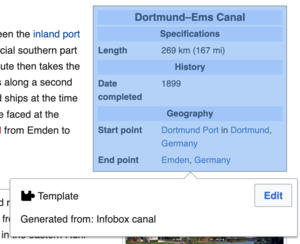 |
| Some templates are not visible to someone reading a page. In the visual editor, such hidden templates are still shown so that you can click and edit or delete them. The name of the template will be shown next to the puzzle icon and both will be grayed out. |  |
Template parameters | |
| You’ll see this dialog box when you’re adding a new template or editing one already in place. What you see in the box depends on whether the template in question contains TemplateData, helpful metadata added by other editors to make it easier to edit templates in the Visual Editor.
When a template contains TemplateData, the VisualEditor can use it to present annotated fields for you to fill in.
|
 |
| You can disable any optional parameter (which have blue checkboxes on the left side). If a parameter’s checkbox is grayed out and not clickable, the template requires that parameter, so it can’t be disabled.
When you insert a new template, you may find that some optional parameters are pre-selected. That means the author(s) of the template recommends the use of those parameters. It’s best to review all parameters that will be used in a template to ensure you understand their use. Clicking an unchecked parameter adds it to the template. Clicking a parameter that’s already been added takes you to the parameter’s input field. Some template parameters will show as “deprecated”. Don’t use deprecated parameters when inserting a template; they’re only visible to you because those parameters are in use on older pages where this template was included. |
 |
Adding undocumented parameters | |
| If you’re inserting or editing a template whose author hasn’t laid out its parameters in TemplateData, it has what we call “undocumented” or “unnamed parameters”. In these cases, you should consult the page for the template itself. There you can learn how to correctly employ and work with all of the template’s parameters. This includes learning the exact names of the parameters as written by the template author.
If you find in the documentation that the template expects parameters without names, fill in numbers as placeholders for the parameter names using the undocumented parameter input, then add text to the values you want to provide as you normally would. Example:
If you accidentally include nonexistent, misspelled or erroneous parameters, the values you enter for those parameters won’t show up on the page you’re editing. |
 |
Autogenerated parameters | |
| In this example, the template in question lacks TemplateData but it was possible to autogenerate the parameters. This means that the undocumented parameters have already been added for you, but the names may not be easily understandable and the dialog cannot display any directions or descriptions. As a result the dialog box provides a link to the template’s documentation, which should help you deduce and fill in the template’s various parameters. |  |
Editing multi-part template content | |
| During editing, you may open template content consisting of multiple templates or a single template linked to some wikitext. This differs from the nested templates described below. In this case, the templates are better visualized as being stacked or connected.
This content often contains “unbalanced templates,” templates which are incomplete on their own and need to be paired with some wikitext or another template in order to function. These related pieces of template content must be created in wikitext, but can be edited in the VisualEditor. In these cases you will see a notice at the top of the dialog to signal the situation and a specialized toolbar will be visible at the bottom of the sidebar. There you can use the icon buttons to add additional templates, additional wikitext, delete elements or change their order. |
 |
Nested templates | |
| Templates can include other templates as the value for parameters. You’ll recognize it when you see a parameter whose value contains the double curly braces ( {{ }} ) denoting a template.
The VisualEditor can’t present this template within a template (a nested template) using the editor’s easy-to-use interface, so if you want to nest a template yourself, you’ll need to understand how to add the template by hand in wikitext into the appropriate parameter field. |
 |
Completing your edit | |
| When you have finished editing a template, you can click "Apprica modiffiche". Then you can preview your edit and make sure it looks the way you want and expect.
You may also see an error message, which (like the other TemplateData mentioned above) is community-provided content and may vary in usefulness. You may need to consult the template’s own documentation to get to the bottom of some errors. If you’re still having trouble, consider posting about your problem on the template’s talk page. |
|
Removing a template | |
| To remove a template in the VisualEditor, click the template box. Press the "Delete" or "Backspace" key on your keyboard. The template will disappear from the page. |  |
Editing on mobile | |
| When editing a template on a page using the VisualEditor on a mobile device, you’ll see that the sidebar starts out hidden. You can make it visible by pressing the “Show/hide options” button. |  |
Substituting templates | |
| When you insert a template in a wiki page, its content and appearance are reevaluated every time the page loads, based on the template code and the values of its parameters. This means if someone updates the code of a template, then every page which uses that template will also get updated when they publish.
There’s another, much less common way to use templates, though, and that’s to substitute a template. Doing this permanently includes the template content just as it appears at the moment you insert it. It will not update if the template code is later changed. Most users won’t ever need to resort to substitution. Substitution is typically only useful when you need to capture the exact appearance of one version of a template, such as when content is under development and needs evaluation. To substitute a template in the VisualEditor, insert a template using the name syntax When you’re finished, press “Inseisci”, which will insert the template content as you see it. |
 |
Editing lists
Editing tables
Editing categories
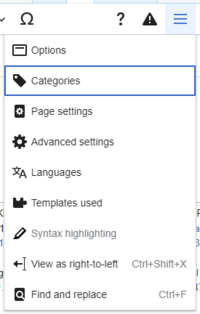 |
To edit categories, on the "Opsioin paggina" menu, press the "Categorie" item. |
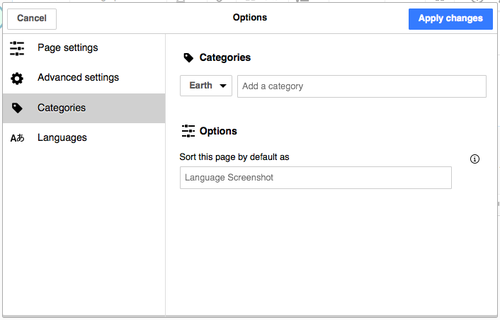 |
Pressing on "Categorie" opens a dialog that lists existing categories and allows you to add new ones, and to delete existing categories.
You also have the option of setting or changing the general (default) sorting key, which determines where the page appears when listed with other pages in the same category. For example, the default sorting key for the article "George Washington" is "Washington, George". In the category "Presidents of the United States", the article is listed under the letter "W", not the letter "G". |
 |
To add a category for a page, type the name of the category into the field "Azonzi 'na categoria". As you type, the visual editor will search for possible matching, existing categories. You can either select an existing category, or you can add a category that doesn't yet have its own category page. (Until that category page is created, your new category will show as a red link after you publish all your editing changes.) |
 |
To remove an existing category, press on it and press on the "Leva" icon (trash can) in the dialog that opens.
Pressing on a category also allows you to specify a sorting key for that specific category. Such a sorting key overrides the default sorting key. |
| Press "Apprica modiffiche" when you are done editing categories to return to the page editor. | |
Editing page settings
Editing maps
 |
You can add and change maps. See Help:VisualEditor/Maps. |
Editing mathematical formulae
Editing musical scores
Editing poems and other special items
Switching between the visual and wikitext editors
Keyboard shortcuts
Many editors are used to entering wikitext directly, especially bold, italics and wikilinks. Keyboard shortcuts allow to quickly apply formatting without having to use toolbar items. Here are some of the most common shortcuts in the visual editor:
| PC shortcut | Action | Mac shortcut |
|---|---|---|
| Ctrl+B | Bold | ⌘ Cmd+B |
| Ctrl+I | Italics | ⌘ Cmd+I |
| Ctrl+K | Insert link | ⌘ Cmd+K |
| Ctrl+X | Cut | ⌘ Cmd+X |
| Ctrl+C | Copy | ⌘ Cmd+C |
| Ctrl+V | Paste | ⌘ Cmd+V |
| Ctrl+Z | Undo | ⌘ Cmd+Z |
Also see the full list of all keyboard shortcuts.















